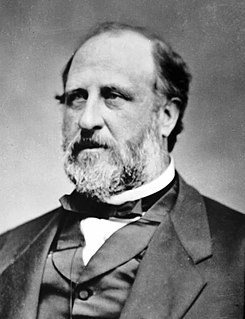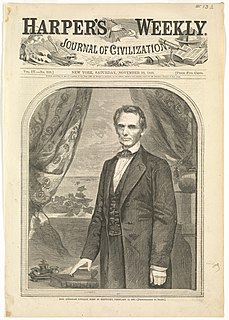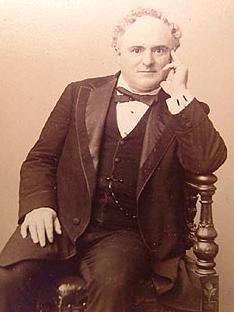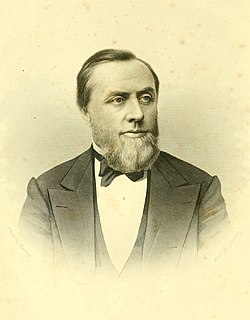
Peter Barr Sweeny (October 9, 1825 New York City – August 30, 1911 Mahopac, Putnam County, New York) was an American lawyer and politician from New York.

Peter Barr Sweeny (October 9, 1825 New York City – August 30, 1911 Mahopac, Putnam County, New York) was an American lawyer and politician from New York.
He was the son of James Sweeny, who kept a hotel in Hoboken, New Jersey, and Mary (Barr) Sweeny.
He attended Columbia College, then studied law, was admitted to the bar and practiced law with James T. Brady [1] in New York City.
In 1852, he was appointed Public Administrator. He was New York County District Attorney in 1858, elected on the Democratic ticket in November 1857, but resigned due to ill health.
Sweeny was City Chamberlain and Park Commissioner under Mayor A. Oakey Hall. He became notorious as a central figure in the ring that controlled Tammany Hall, and was depicted prominently in Thomas Nast's cartoons alongside Boss Tweed, Richard B. Connolly and A. Oakey Hall.
With Tweed, he was a director of the Erie Railroad, which became "a gigantic highway of robbery and disgrace". [2] Sweeny was also Director of the Tenth National Bank, in which city funds were deposited. In Nast's cartoons, Tweed and Sweeny were often identified as "Tweeny and Sweed"; in others, Sweeny was identified as "Peter 'Brains' Sweeny". Public indignation over the theft of millions of dollars by the Tweed ring led to the downfall of the Ring in the municipal election of November 7, 1871. Sweeny resigned from public life the following day. [3] In February 1872, Sweeny was indicted but the D.A.'s office decided for nolle prosequi, and Sweeny went to Canada.
In 1877, Sweeny paid $400,000 to New York City in exchange for forgiveness. The fact that the sum was paid in the name of his recently deceased brother, James M. Sweeney, who had been a minor player in the financial operations of the Ring, was widely condemned in the press. On June 7, 1877, the Evening Post wrote, "Of course, nobody will be deceived by this disgraceful and offensive sham. The suit of the people was not against James M. Sweeny ... It is known that he lived by the breath of his brother, that he was but a mere miserable tool". [3]
Sweeny died at the home of his son Arthur Sweeny, Assistant Corporation Counsel of New York City.

William Magear Tweed, often erroneously referred to as "William Marcy Tweed", and widely known as "Boss" Tweed, was an American politician most notable for being the "boss" of Tammany Hall, the Democratic Party political machine that played a major role in the politics of 19th-century New York City and State. At the height of his influence, Tweed was the third-largest landowner in New York City, a director of the Erie Railroad, a director of the Tenth National Bank, a director of the New-York Printing Company, the proprietor of the Metropolitan Hotel, a significant stockholder in iron mines and gas companies, a board member of the Harlem Gas Light Company, a board member of the Third Avenue Railway Company, a board member of the Brooklyn Bridge Company, and the president of the Guardian Savings Bank.

Thomas Nast was a German-born American caricaturist and editorial cartoonist often considered to be the "Father of the American Cartoon". He was a critic of Democratic Representative "Boss" Tweed and the Tammany Hall Democratic party political machine. Among his notable works were the creation of the modern version of Santa Claus and the political symbol of the elephant for the Republican Party (GOP). Contrary to popular belief, Nast did not create Uncle Sam, Columbia, or the Democratic donkey, though he popularized those symbols by his artwork. Nast was associated with the magazine Harper's Weekly from 1859 to 1860 and from 1862 until 1886.

Harper's Weekly, A Journal of Civilization was an American political magazine based in New York City. Published by Harper & Brothers from 1857 until 1916, it featured foreign and domestic news, fiction, essays on many subjects, and humor, alongside illustrations. It carried extensive coverage of the American Civil War, including many illustrations of events from the war. During its most influential period, it was the forum of the political cartoonist Thomas Nast.

George Jones was an American journalist who, with Henry Jarvis Raymond, co-founded the New-York Daily Times, now The New York Times.
James M. Smith Jr was an American lawyer and politician from New York.

The Tweed Courthouse is a historic courthouse building at 52 Chambers Street in the Civic Center, Manhattan, New York City. It was built in the Italianate style with Romanesque Revival interiors. William M. "Boss" Tweed – the corrupt leader of Tammany Hall, a political machine that controlled the New York state and city governments when the courthouse was built – oversaw the building's erection. The Tweed Courthouse served as a judicial building for New York County, a county of New York state coextensive with the New York City borough of Manhattan. It is the second-oldest city government building in the borough, after City Hall.

Abraham Oakey Hall was an American politician, lawyer, and writer. He served as Mayor of New York from 1869 to 1872 as a Democrat. Hall, known as "Elegant Oakey", was a model of serenity and respectability. Recent historians have disputed the older depiction of Hall as corrupt or as a front man for a corrupt political order.

John R. Fellows was an American lawyer and politician from Arkansas and New York. He served as New York County District Attorney, and a member of Congress from New York (1891-1893).

John Cochrane was an American lawyer, Union Army general and politician.
Levi Starr Chatfield was an American lawyer and politician.

The 1904 New York state election was held on November 8, 1904, to elect the governor, the lieutenant governor, the secretary state, the state comptroller, the attorney general, the state treasurer, the state engineer, the chief judge and an associate judge of the New York Court of Appeals, as well as all members of the New York State Assembly and the New York State Senate.

The 1860 New York state election was held on November 6, 1860, to elect the governor, the lieutenant governor, a Canal Commissioner, and an Inspector of State Prisons, as well as all members of the New York State Assembly. Besides, the question of Negro suffrage was asked, and was answered in the negative with 197,503 votes for and 337,984 against it.

Nelson Jarvis Waterbury was an American lawyer and politician from New York.
Samuel Bostwick Garvin was an American lawyer and politician from New York.
Peter Butler Olney was an American lawyer and politician from New York.

Richard Barrett Connolly was an American politician from New York.
John J. Bradley was an American politician from New York and one of the members of the infamous Tweed Ring.
Michael Norton was an American politician from New York.
Henry Webb Genet was an American lawyer and politician from New York.
Elbirt Almeron Woodward was a major figure in the Boss Tweed corruption scandal in 1871. He served as the assistant clerk to the New York City Board of Supervisors. He was a member of the Connecticut Senate representing the 12th District from 1870 to 1871. At the Democratic State Convention a year after his term as senator, he received 89 votes for the party's nomination for Lieutenant Governor of Connecticut. Although he was most commonly referred to as "Elbert A. Woodward," his true given name was spelled "Elbirt" as proven by examples of his actual handwritten signature.
| Legal offices | ||
|---|---|---|
| Preceded by A. Oakey Hall | New York County District Attorney 1858 | Succeeded by Joseph Blunt |